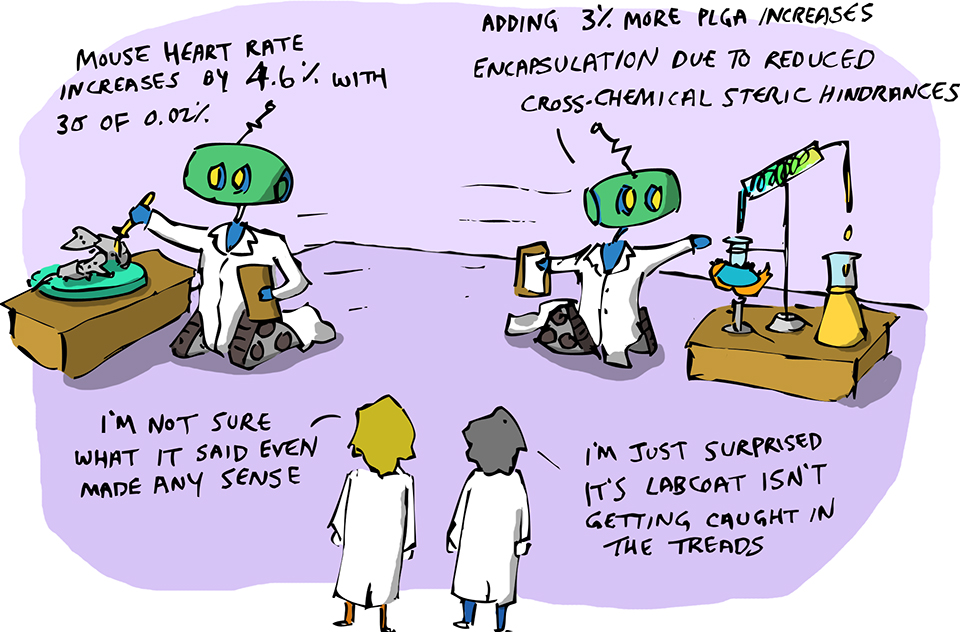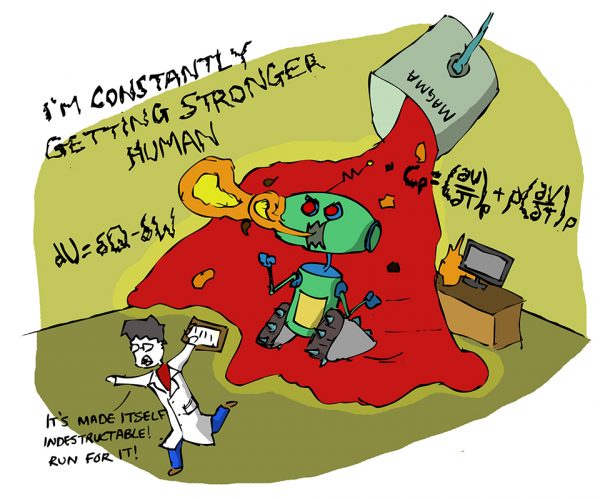Erin Bedford, Technology and Engineering co-editor
Illustrations by Geoffrey Lee, Sketchy Science
We’re in the midst of a revolution in materials science – artificial intelligence (AI) is changing the way we discover new materials. Scientists don’t have to worry about being replaced by machines anytime soon, however. Rather than replacing the thought-work of researchers, AI is expanding materials science research into new territory through more efficient data analysis and modeling.
Innovations in materials underlie most technological advancements throughout history. Where would we be without concrete, the literal foundation of civilization, or steel, shaping history as weapons, tools, and infrastructure? In the last century, advances in materials such as plastics, silicon semiconductors, and, most recently, nanotechnology have revolutionized society.
Materials research moves slowly. Outside of rare, serendipitous discoveries (which have always played an important role in science), the creation of a new material is largely driven by what has worked before, what we think might work better, and how far we can push the limits of what we know how to make. The process of discovering and optimizing a new material takes months, even years. Entire PhD theses are written on the synthesis and study of a single molecule or new material.
But materials research is in the process of a transformation. Artificial intelligence – the same technology that has given us self-driving cars, Amazon’s product recommendations, and Siri – is providing a way to speed up and change the way we discover new materials. This technology (used synonymously in popular culture with the methods used to implement it, like machine learning and deep learning) involves developing machines that can do tasks that normally require human intelligence, like learning, problem-solving, “sensory” perception, and decision-making.
When it comes to materials science, AI offers the possibility of speeding up the materials-discovery process. Traditionally, scientists design a new material, make it, and then test it, but this approach has limitations.
“We can try to use chemical intuition to understand a system or systematically change a few things, but you’re only sampling a small amount of space,” says Phil De Luna, a PhD candidate at the University of Toronto working on integrating machine-learning methods into materials science. “Machine learning gives us a tool to search a large amount of space in a small amount of time.”
Using AI to search for new or improved materials is like using a satellite – it gives the researcher an understanding of a much larger area of land than could be obtained by investigating on-foot. The satellite image directs scientists to certain areas, potentially leading them to explore something that they would not have known about using traditional research methods.
“It’s a helper for discovery rather than doing the discovery itself,” Phil emphasizes.
Machine learning requires input on what to look for, where to look, and data that the machine can learn from. Phil’s current work involves developing catalysts that can convert carbon dioxide into useful materials, like renewable fuels and plastics. His experimental work developing these nanostructured materials provides important data, but there are an enormous number of parameters that can affect how well the catalysts work, like their composition or shape. Because synthesizing these new materials takes time, machine learning methods can find trends that will help guide Phil to synthesize only the materials that are most likely to work well.
In the same way that we require information to make informed judgments, AI requires data to provide results. The enormous amounts of materials data that are currently available – ranging from the chemical makeup of materials to how they behave in different conditions (mechanical properties under stress or electromagnetic properties in an energy field) – combined with improved computing power, are what make applying AI methods in materials science possible. The availability of data determines where these methods are applied.
Pharmaceutical companies, for example, have been keeping data on the synthesis, structure, and effects of potential drug molecules for years, providing an excellent platform for applying AI methods to drug discovery. Combined with automated synthesis systems, what once was the domain of scientists in lab coats is quickly becoming the domain of robots.

Illustration by Geoffrey Lee, Sketchy Science
The biological sciences are the current leaders in using AI and robotics in synthesis, but recent calls to incorporate AI into other areas, such as energy-materials research (also a CIFAR initiative), show that they’re not alone. Toyota is investing $35 million in research that uses AI to develop advanced materials, a project that Phil is excited to be involved in.
Newer companies are also trying to capitalize on these technological advances. Citrine Informatics has developed AI software to narrow the choice of materials to test for a given application. Boeing is using it to improve metal alloys for 3D printing jet parts. Zymergenis combining AI and automation in biology and materials science to improve industrial microbes that produce compounds used to make fuels, plastics, or drugs.
Phil is quick to mention that there’s a difference between the AI he’s working on and that discussed in popular culture, where fears regarding the ethics of self-driving cars and the potential AI apocalypse tend to dominate the conversation. “It’s important to remember that this is a tool, similar to how computers revolutionized information technology or the calculator revolutionized math. Machine learning is going to do the same thing for discovery.”
Still, a risk of AI is that we don’t always know why it’s giving us the answers that it does. “We need to understand the limitations. It can’t just be a black box,” Phil states emphatically.
While machine learning is currently great at doing things that humans already know how to do (but often faster or with fewer complaints), Phil is interested in finding out if machine learning can discover new things that humans can’t – learning without set bounds.
“I’m really excited about where this is going,” Phil says, when discussing the future of AI in materials science, “I think it’s great that more and more people are getting involved in it.”
Illustration by Geoffrey Lee, Sketchy Science
~30~





